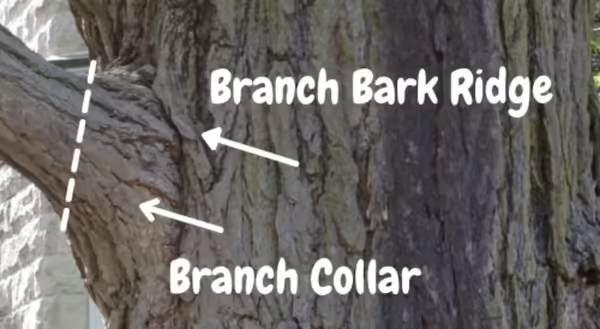
Like a scene from an old western: with a pair of sterilized pruners, and her boots, horticulturists Kelly Allsup walks up to the newly planted English White oak hybrid. Her sole intent of increasing the life of an urban tree. She walks around the tree, looking it up and down. The goal of pruning is to remove branches that will cause structural problems in the future, reduce competition of the central leader, and keep a balanced canopy. Kelly is ready to prune.
Pruning is done while the trees are in their dormant stage before roots start pushing bud growth in the spring. If you want to increase the life of the tree in your yard, here are a few definitions and tips:
Limbs have a ‘branch bark ridge’ and ‘branch collar.’ The branch bark ridge is where the bark from the limb and the trunk collide and create a ridge. The branch collar, a bulge at the base of the limb, is integral in healing a pruning cut, sealing off the limb. If you cut either of these from the tree, your pruning cut will not heal well and be a potential avenue for insects and diseases.
After you are comfortable identifying branch bark ridge and branch collar, remove branches that are broken, damaged, or crossing, being sure to not cut into the branch collar.
Next, head back any branches that are competing with the central leader. Usually there are multiple branches at the top of the tree competing for dominance. The straightest will be your dominant leader. The other branches that are competing should be cut back to a node. A node is usually where leaves are attached, with scars visible in winter up and down the stem. This heading cut will stunt these competitors. These can even be removed all the way to the trunk if they don’t leave too obvious of a gap in the canopy.
Finally, head back aggressive side branches. Arborists look at the branch aspect ratio—the lateral branches should be less than half the size of the trunk. If they are allowed to achieve the same girth as the trunk, they fail as the tree grows older.
This is how a tree grows in the nature. A strong, stable trunk and with small lateral branches. In forests, trees are huddled together, preventing side branches from getting much light, and therefore remaining narrower than the trunk. When trees are in an urban setting, they have more space above ground to grow more aggressively. (The space they have underground is another story for another day.)
By pruning, you stunt the trees’ growth that way nature would, and help your tree live a longer, healthier life than its unpruned tree friends.